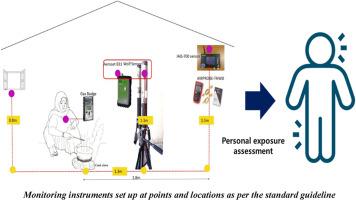尼泊尔喜马拉雅地区单细胞房屋室内空气质量评价及暴露分析
IF 3.7
2区 环境科学与生态学
Q2 ENVIRONMENTAL SCIENCES
引用次数: 0
摘要
在尼泊尔的喜马拉雅地区,大多数家庭是单细胞房屋(SCH),家庭在一个单一的共享空间中做饭、取暖、睡觉和进行日常活动。木柴和其他生物质燃料通常用于烹饪和取暖,特别是在寒冷的季节。这种燃烧过程释放有害污染物,如一氧化碳(CO)、二氧化碳(CO2)和细颗粒物(PM2.5),严重降低室内空气质量(IAQ),并对居民构成严重的健康风险。本研究旨在评估室内空气品质,并评估室内空气污染物暴露及相关健康风险。在不同通风条件下,连续5天对每间房屋进行24 h的室内空气质量参数连续实时监测。CO和PM2.5的浓度分别为25.11±14.24 ppm和793.8±117.36 μg/m3,分别超过国际健康指南的3.6倍和32倍。由于烹饪和取暖使用火的时间延长,居民每天暴露在污染物浓度升高的环境中长达14小时。吸入暴露模型显示,人均每日污染物摄入量为248.59 mg CO和6849.74 μg PM2.5。监测场景的空气质量指数(AQI)范围从150到430,表明不健康到危险水平。这些发现突出表明,迫切需要改进通风系统和更清洁的烹饪技术,以减轻寒冷地区依赖柴火的家庭的室内空气污染和降低健康风险。本文章由计算机程序翻译,如有差异,请以英文原文为准。

Assessment of indoor air quality and exposure analysis of single cell houses of the Himalayan region of Nepal
In the Himalayan region of Nepal, the majority of households are single-cell houses (SCH) where families cook, heat, sleep, and perform daily activities in a single shared space. Firewood and other biomass fuels are commonly used for cooking and heating, especially during cold seasons. This combustion process releases harmful pollutants, such as carbon monoxide (CO), carbon dioxide (CO2), and fine particulate matter (PM2.5), significantly degrading indoor air quality (IAQ) and posing serious health risks to residents. This study aims to assess indoor air quality and evaluate pollutant exposure and associated health risks among occupants of SCHs.
Continuous real-time monitoring of IAQ parameters was conducted for 24 h over five consecutive days in each house under varying ventilation conditions. CO and PM2.5 concentrations were found to be 25.11 ± 14.24 ppm and 793.8 ± 117.36 μg/m3, respectively—exceeding international health guidelines by up to 3.6 times for CO and 32 times for PM2.5. Residents are exposed to elevated pollutant concentrations for up to 14 h daily due to extended fire use for both cooking and heating. Inhalation exposure modeling revealed average daily pollutant intakes of 248.59 mg of CO and 6849.74 μg of PM2.5 per person. The Air Quality Index (AQI) across monitoring scenarios ranged from 150 to 430, indicating unhealthy to hazardous levels.
These findings highlight the urgent need for improved ventilation systems and cleaner cooking technologies to mitigate indoor air pollution and reduce health risks in firewood-dependent households in cold regions.
求助全文
通过发布文献求助,成功后即可免费获取论文全文。
去求助
来源期刊

Atmospheric Environment
环境科学-环境科学
CiteScore
9.40
自引率
8.00%
发文量
458
审稿时长
53 days
期刊介绍:
Atmospheric Environment has an open access mirror journal Atmospheric Environment: X, sharing the same aims and scope, editorial team, submission system and rigorous peer review.
Atmospheric Environment is the international journal for scientists in different disciplines related to atmospheric composition and its impacts. The journal publishes scientific articles with atmospheric relevance of emissions and depositions of gaseous and particulate compounds, chemical processes and physical effects in the atmosphere, as well as impacts of the changing atmospheric composition on human health, air quality, climate change, and ecosystems.
 求助内容:
求助内容: 应助结果提醒方式:
应助结果提醒方式:


